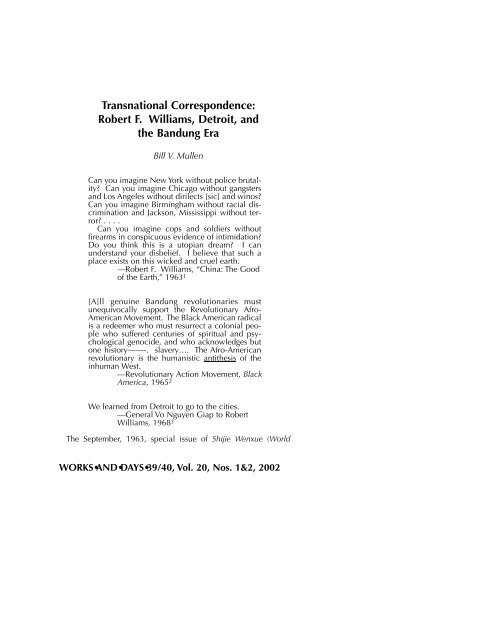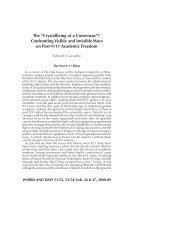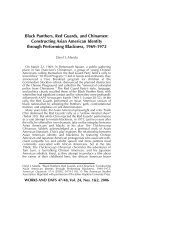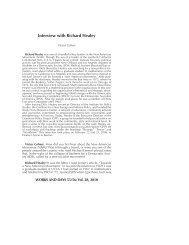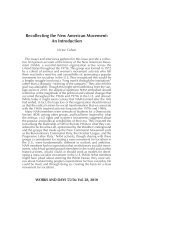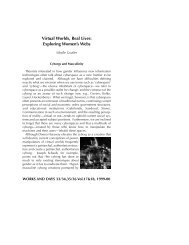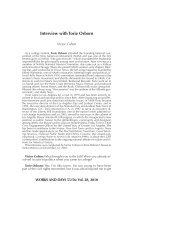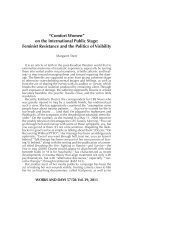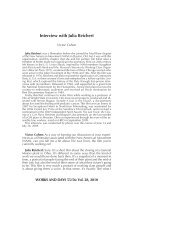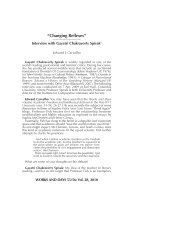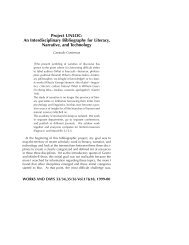Transnational Correspondence: Robert F ... - Works and Days
Transnational Correspondence: Robert F ... - Works and Days
Transnational Correspondence: Robert F ... - Works and Days
Create successful ePaper yourself
Turn your PDF publications into a flip-book with our unique Google optimized e-Paper software.
<strong>Transnational</strong> <strong>Correspondence</strong>:<strong>Robert</strong> F. Williams, Detroit, <strong>and</strong>the B<strong>and</strong>ung EraBill V. MullenCan you imagine New York without police brutality?Can you imagine Chicago without gangsters<strong>and</strong> Los Angeles without dirilects [sic] <strong>and</strong> winos?Can you imagine Birmingham without racial discrimination<strong>and</strong> Jackson, Mississippi without terror?. . . .Can you imagine cops <strong>and</strong> soldiers withoutfirearms in conspicuous evidence of intimidation?Do you think this is a utopian dream? I canunderst<strong>and</strong> your disbelief. I believe that such aplace exists on this wicked <strong>and</strong> cruel earth.—<strong>Robert</strong> F. Williams, “China: The Goodof the Earth,” 1963 1[A]ll genuine B<strong>and</strong>ung revolutionaries mustunequivocally support the Revolutionary Afro-American Movement. The Black American radicalis a redeemer who must resurrect a colonial peoplewho suffered centuries of spiritual <strong>and</strong> psychologicalgenocide, <strong>and</strong> who acknowledges butone history——-. slavery…. The Afro-Americanrevolutionary is the humanistic antithesis of theinhuman West.—Revolutionary Action Movement, BlackAmerica, 1965 2We learned from Detroit to go to the cities.—General Vo Nguyen Giap to <strong>Robert</strong>Williams, 1968 3The September, 1963, special issue of Shijie Wenxue (WorldWORKS•AND•DAYS•39/40, Vol. 20, Nos. 1&2, 2002
190 WORKS•AND•DAYSLiterature) published in Beijing was dedicated to W. E .B. Du Bois.The lyric poet to China, twice a visitor there, had died in August onthe eve of the March on Washington. Working quickly, the editorshad compiled an extraordinary gathering of writers <strong>and</strong> writings inhis name. They included Du Bois’s own poem “Ghana Calls,” writtento commemorate his final exile; Sie Ping-hsin’s “To Mourn forthe Death of Dr. W Du Bois”; Margaret Walker’s poem “SorrowfulL<strong>and</strong>”; <strong>and</strong> a short story “The Tokolosh” by the South African writerRonald Segal. Also included were pedagogical texts on blackstruggle to which 1963 seemed an immediate heir: “HistoricalDocuments of the Struggle for Negroes’ Emancipation,” includingan excerpt from Frederick Douglass’s Narrative; Han Peh-ping’s“Notes on Negroes’ Oral Literature in West Africa”; <strong>and</strong> three articlesdescribed as “anecdotes” about <strong>Robert</strong> F. Williams, the formerhead of the Monroe, North Carolina, NAACP now living in exile inCuba after being charged by the FBI with kidnapping during a 1961uprising in his hometown. In Cuba, incidentally, Williams publishedfavorable articles <strong>and</strong> editorials about China in the pages ofThe Crusader, his self-started newspaper. In the fall of 1963,Williams <strong>and</strong> his wife Mabel made their first visit to China <strong>and</strong>North Vietnam as invited guests of their respective governments.The trip was precipitated by a letter-writing campaign by Williamsto Chairman Mao Tse-Tung, urging him to make a statement of supportin the escalating crisis for black Americans. After the racistbombing of the 16 th Street Baptist Church in Birmingham inSeptember, killing four African-American girls, Mao released his“Support for the American Negroes in their Struggle Against RacialDiscrimination <strong>and</strong> for Freedom <strong>and</strong> Equal Rights.” Another statementby Mao, titled “Calling upon People of the World to Unite toOppose Racial Discrimination by U.S. Imperialism <strong>and</strong> Supportthe American Negroes Struggle Against America” prefaced theissue of Shijie Wenxue.Mao’s statements of support were welcome, if overdue, news toblack radicals in the United States, particularly in the city ofDetroit, for whom <strong>Robert</strong> Williams was likewise both geographicallyremote yet symbolically present. Williams lived briefly in thecity in 1942 <strong>and</strong> 1948. While there, he was an autoworker <strong>and</strong>member of UAW 600. His commitment to armed self-defenseagainst racist attacks in North Carolina as early as 1957 hadbrought him to the attention of Detroit activists well before he wascharged in the Monroe uprising in ‘61. Immediately following thatcharge, supporters in Detroit formed the <strong>Robert</strong> Williams DefenseCommittee. In May of 1962, the Detroit journal <strong>Correspondence</strong>,edited by Chinese-American activist Grace Lee Boggs, publishedPamphlet 5, Monroe, North Carolina…Turning Point in AmericanHistory. The pamphlet comprised two speeches in Williams’sdefense by his attorney Conrad J. Lynn <strong>and</strong> a foreword by JamesBoggs, a Detroit worker <strong>and</strong> husb<strong>and</strong> to Grace, comparingWilliams frame-up to the Emmett Till case.In September, 1963, the same month as the special issue ofWorld Literature, Detroit poet Dudley R<strong>and</strong>all wrote his own
Mullen 191response to the Birmingham bombing, “Ballad of Birmingham,” ahaunting lament for the four little girls killed in the blast. At theBoggs’s invitation, the poem was published in the October<strong>Correspondence</strong>. A month earlier, Boggs had published R<strong>and</strong>all’smore polemical “Roses <strong>and</strong> Revolution,” written in 1948 <strong>and</strong> publishedin 1949, the year of the formation of the People’s Republicof China. The poem compared a U.S. lynching victim “lying in theswamp with his face blown/off” to all of the war dead, includingthe victims of the atomic bombs dropped on Hiroshima <strong>and</strong>Nagasaki (3). After imagining a “vision of a time when all menwalk proudly through the earth/<strong>and</strong> the bombs <strong>and</strong> missiles lie atthe bottom of the ocean,” the poem closes with this politicalepiphany:Then washed in the brightness of this vision,I saw how in its radiance would grow <strong>and</strong> benourished <strong>and</strong> suddenlyburst into terrible <strong>and</strong> splendid bloomthe blood-red flower of revolution. (3)These synchronous acts of political <strong>and</strong> cultural translation constitutea singular story of internationalism during the 1940-60s.Black America’s call to Asia, <strong>and</strong> Asia’s reciprocal response, revealsthe textual <strong>and</strong> logistical mechanics of what might be called“transnational correspondence.” Beginning with the 1955 meetingof decolonizing African <strong>and</strong> Asian nations in B<strong>and</strong>ung, Indonesia,until at least the early 1970s, African-American <strong>and</strong> Asian radicalsimagined themselves as antipodal partners in Cultural Revolution,pen pals for world liberation. Motivated by real <strong>and</strong> imagined affiliationsbetween race <strong>and</strong> Civil Rights struggles in the U.S., anticolonialmovements in the Third World, the Cuban <strong>and</strong> GreatChinese Proletarian Cultural Revolutions, <strong>and</strong> a U.S. imperialistwar in Vietnam, such correspondents circulated among <strong>and</strong>between themselves a conception of political simultaneity <strong>and</strong>indebtedness meant to inform developments on opposite sides ofthe earth. <strong>Transnational</strong> correspondence refers specifically to theattempts by black radicals in the U.S. <strong>and</strong> liberation leaders in Asiato establish strategic linkages in three areas of international struggle:military strategizing, including guerilla tactics; literary <strong>and</strong>publishing strategies; <strong>and</strong> cultural revolution. General Vo NgyuenGiap’s apocryphal quip to <strong>Robert</strong> Williams ascribing the success ofNorth Vietnamese military operations to the example of Detroit’surban rebellions of 1967 is but one startling metonym for theseprocesses. It captures the real <strong>and</strong> symbolic role Afro-Asian radicalismhad come to play in the U.S. as rumors about an“Operation Giap,” an assault by the U.S.-based RevolutionaryAction Movement, circulated through black undergrounds <strong>and</strong> theradical black press of 1966 (see SAGA). It resonates with two oftcirculateddeclarations by leading exponents of Afro-Asian revolutionarytheory of the 1960s: <strong>Robert</strong> Williams’s “America is theBlack Man’s Battleground” (“Urban” 6), a plaintive insistence that
192 WORKS•AND•DAYShis comrades carry the war at home during his own Cuban <strong>and</strong>later Chinese exile; <strong>and</strong> Detroiters James <strong>and</strong> Grace Lee Boggs’s“The City is the Black Man’s L<strong>and</strong>” (Racism 41). Both slogans figuredprominently in the efforts of organizations like the NorthernGrassroots Leadership Conference, the Freedom Now Party, theRevolutionary Action Movement, the Republic of New Africa, <strong>and</strong>the Inner City Organizing Committee to implement Chinese,Vietnamese, <strong>and</strong> Latin American guerilla strategies of military <strong>and</strong>ideological warfare that insisted upon a geographical base (be itcountry or city) for the carrying out of revolution.Attempts to link political tactics to relevant forms of black culturalwork also followed Asia’s example. Especially influential inthis effort was Mao’s 1942 “Talks at the Yenan Forum on Art <strong>and</strong>Literature.” This seminal essay provided a theoretical template forFirst World radicals to deploy what black arts theoretician LarryNeal called “useable elements of Third World culture” (1963). Itmotivated black artists <strong>and</strong> writers in particular to incorporateMaoist ideas <strong>and</strong> an internationalist perspective into publications<strong>and</strong> activities formative of the black arts movement in the U.S.Such incorporation is revealed in the torrent of publications, manifestos,books, magazines, newspapers, poems, pamphlets, <strong>and</strong>journals that literally circulated from Beijing to Detroit to Havanato Hanoi <strong>and</strong> beyond. These writings describe black arts as anintellectual <strong>and</strong> textual diaspora of the 1960s. At the same time,the use of literary texts <strong>and</strong> the printed word as a vehicle for internationalsolidarity underscored political distinctions <strong>and</strong> differencesdifficult to overcome. Efforts to equalize such disparateevents as the Watts Rebellion of 1965 <strong>and</strong> the Algerian struggleagainst French colonialism were often unresolved or concluded inmakeshift ideologies <strong>and</strong> temporary or transient positionings. Thisgave the B<strong>and</strong>ung Era its quixotic revolutionary aura of upstartalliances, improvisatory strategies, <strong>and</strong> synthetic vocabularies fordefining Afro-Asian liberation. One example particularly relevantto this essay is the word “black.” In their influential writings to bediscussed in detail later, groups such as the Revolutionary ActionMovement (RAM) came to re-define the term as one of relationalpolitical (as opposed to racial) meaning. Their call for a “unity ofblack nationalist (s)” throughout the world defined revolutionaryblack internationalism as a “philosophy of co-operation…It is thephilosophy of a common international cultural heritage <strong>and</strong> identityamong all non-European people, that is African, Asian <strong>and</strong>South American people all have similar if not the same cultural histories<strong>and</strong> have a common destiny” (World Literature 31). RAM’sparallel assertion that the “Afro-American revolutionary” is thehumanistic “anti-thesis” of the inhuman West counterposed“counter-revolutionary” white hegemony to its revolutionary other(Ibid 31). This conception of correspondence was a necessarylinchpin for bringing Afro-Asian struggles together. It evoked astrategic anti-essentialism meant to delink binaries of racial <strong>and</strong>political separation (African <strong>and</strong> Asian/First World <strong>and</strong> Third/Orient<strong>and</strong> Occident). <strong>Transnational</strong> correspondence also became a
Mullen 193means for dialectical underst<strong>and</strong>ing of social relations under capitalisminternationally <strong>and</strong> for exposing links in the chain of postwarimperialism <strong>and</strong> colonialism. Underst<strong>and</strong>ing the paradigm oftransnational correspondence thus helps to disclose how black <strong>and</strong>Asian radicals prolonged <strong>and</strong> re-made the so-called “B<strong>and</strong>ung Era”into a distinctly black formula for liberation.The momentous April, 1955, conference of 29 independenceseekingAfrican <strong>and</strong> Asian nations in B<strong>and</strong>ung, Indonesia, intendedto foster Afro-Asian unity, concluded with specific but limitedconcrete gains for both. The conference was organized by headsof state of Burma, India, Indonesia, Ceylon, <strong>and</strong> Pakistan to commemoraterecent <strong>and</strong> ongoing decolonization efforts in Asia <strong>and</strong>Africa. India’s Jawaharlal Nehru had brokered invitations to theevent, which included China but not the Soviet Union. The conferencefeatured numerous speeches by Afro-Asian heads of state,including President Achmad Sukarno of Indonesia <strong>and</strong> China’sZhou Enlai, <strong>and</strong> concluded with a consensual resolution condemningcolonialism “in whatever form it appears” (Kahin 43).Out of the event had come the formation of the Afro-AsianJournalists Association, a network of newspapers <strong>and</strong> informationexchange; the Afro-Asian Writers Bureau, a sister organization;increased economic <strong>and</strong> political cooperation between China <strong>and</strong>developing African nations; extended cooperation betweenAfrican, Asian, <strong>and</strong> Latin American anti-colonial movements; <strong>and</strong>follow-up conferences such as the Havana TricontinentalConference of 1966, which saw the founding of the Organizationof Solidarity of the Peoples of Africa, Asia, <strong>and</strong> Latin America.Rewards or consequences for African-Americans were more difficultto discern. Limited African-American participation in <strong>and</strong>reporting of the event, including that by Richard Wright <strong>and</strong> AdamClayton Powell, had been framed mainly in terms of the benefitsAfro-Asian solidarity might accrue to democratic capitalism orSoviet communism, <strong>and</strong> the pitfalls of Cold War alliances forAfrican <strong>and</strong> Asian nations. As Penny Von Eschen <strong>and</strong> MaryDudziak have documented, valiant African-American efforts tomaintain strategic alliances with socialist, communist or decolonizingmovements in Africa <strong>and</strong> Asia during the 1950s generallywere limited in their success by domestic Cold War restraints <strong>and</strong>recriminations. In particular, restricting the geographical movementof black radicals by refusing them passports (Paul Robeson<strong>and</strong> W. E. B. DuBois for example) became a crucial way to preventthe construction of anti-colonial bridges.<strong>Robert</strong> Williams’s example <strong>and</strong> activities in North Carolina,Cuba, <strong>and</strong> China came to bear as significant disturbances to thisplacid framework. As Timothy Tyson has documented, Williams’srole in making prominent the range of acts of white terror againstAfrican-American citizens in North Carolina in the late 1950s weretimely fodder for both African-American activists <strong>and</strong> U.S. ColdWar opponents attempting to destabilize U.S. self-representation ofracial democracy. Chinese, Soviet, <strong>and</strong> other international papers,
194 WORKS•AND•DAYSfor example, as well as African-American <strong>and</strong> Left newspaperswithin the U.S., raced to tell the story of Hanover Thompson <strong>and</strong>Fuzzy Simpson, two young boys criminally accused for kissing awhite girl in Monroe in 1957. When Williams took the localNAACP lead in protesting the case, he <strong>and</strong> his attorney ConradLynn were publicly accused of being Communist by Chester Davis,a former FBI agent turned journalist (Tyson 132-33). Williams’sconspicuous role as a public challenger to NAACP leadership,however, endeared him to white <strong>and</strong> black radicals alike, particularlythose disinclined towards anti-communism. It also foreshadowedhis role in the signal event which revived <strong>and</strong> described amore prescient internationalism for black radicals in the B<strong>and</strong>ungera; namely, Williams’s much-publicized frame-up, escape, <strong>and</strong>exile to Cuba after the 1961 uprisings.Williams, along with Julian Mayfield, Amiri Baraka <strong>and</strong> others,had through work with Fair Play for Cuba already helped to makethe country at least a symbolic outpost of black internationalisthopes. Williams’s exile there in 1961 made Cuba an even moretangible sphere of influence as safe harbor for black militants. Itgave increased credibility to the Cuban revolution <strong>and</strong> socialism asviable allies for black domestic struggle. Likewise, it renewedinterest among black revolutionaries in Latin American politicalstruggles, particularly the figure of Che Guevara. Williams’s outspokensupport for China from Cuba also began to warm black earsto that country’s call. (Du Bois’s exile to Ghana after his 1959 visitto China was a preamble to this, as understood by the editors ofWorld Literature.) Williams insisted that black Americans shouldside with China in the Cold War Sino-Soviet split of the late 1950s(“Sino-Soviet” 26). He argued that China’s challenge to Soviethegemony was tantamount to his own challenge to Americanracism. The Chinese Revolution also captured the B<strong>and</strong>ung spiritof political self-determination <strong>and</strong> non-alignment that incidentallyparalleled his own highly independent relationship to bothAmerican Left movements like the Socialist Workers Party <strong>and</strong>more mainstream African-American civil rights struggle. In 1965,discouraged by events in Cuba, Williams accepted an invitationfrom the Chinese government to live in Beijing. From 1965 to ‘69,he continued publication of The Crusader from Beijing <strong>and</strong> gavevociferous support to China’s revolution. Throughout this period ofexile, Williams came to speak to <strong>and</strong> personify for black radicalswhat had been important but abstract—<strong>and</strong> geographically distant—aspectsof the anti-colonial struggle, giving them domesticrelevance <strong>and</strong> gravitas they had previously lacked.Equally important to the larger theme of this essay, Williams recognizedhis exile, as it was recognized within radical U.S. circles,as an example of political <strong>and</strong> cultural correspondence.Particularly for radicals with Marxist leanings, his exile came tosymbolize the idea of black Americans as colonized or internallyexiled figures, an Old Left analysis that would be reconfigured inblack nationalist theory of the 1960s. Also significant to this essay,Williams began to circulate his ideas on these questions by creat-
Mullen 195ing a new information exchange for black internationalists. Hebegan weekly broadcasts of “Radio Free Dixie” on short wave fromHavana, mixing jazz, diatribes about U.S. racism, <strong>and</strong> inspirationalmessages drawn from race struggles at home. “Radio Free Dixie”had a circular discursive logic meant to close the gap betweenhimself <strong>and</strong> America by drawing parallels between his plight inexile <strong>and</strong> the movement at home. Political sermons <strong>and</strong> editorialsby Albert Cleage, pastor at Central United Church in Detroit, forexample, resounded back to American listeners who simultaneouslymight attend a Cleage-sponsored lecture in Detroit on “BlackNationalism in Jazz” (Smith 172).From Cuba, Williams also began publishing his own newspaper,The Crusader, <strong>and</strong> sending it back to the U.S. The paper derivedits name from the newspaper of the African Blood Brotherhood(ABB), the post-World War I collective of African-American <strong>and</strong>West Indian Marxists. The ABB drew part of its membership fromex-Garveyites, <strong>and</strong> comprised the first internationalist black publishingcollective in U.S. history. Williams’s Crusader, available bysubscription in the U.S. <strong>and</strong> distributed with the help of friends inthe U.S. <strong>and</strong> Canada, initially gave uncritically supportive coverageto the Cuban Revolution <strong>and</strong> Castro. The early Crusaders alsoinsisted, without always supporting its claims, that Cuban supportfor black struggle was implicit in its socialist revolution <strong>and</strong> itsemancipation from four centuries of Western slavery. The paperwas read by Civil Rights advocates <strong>and</strong> radicals of a broad stripe—the Amsterdam News, John Killens, the Student Non-ViolentCoordinating Committee (SNCC), Monthly Review Press, <strong>and</strong> MaxRoach were among those listed at one time on Williams’s subscriptionlist (“Subscription List”)—<strong>and</strong> was frequently excerpted inother black <strong>and</strong> left publications back in the U.S.The impact of Williams’s media entrepreneurship as well as hissymbolic significance to radicals at home was nowhere more keenthan in Detroit. General Baker, later a founder of the League ofRevolutionary Black Workers, entered Detroit’s black left throughparticipation in the Detroit <strong>Robert</strong> Williams Defense Committee in1962. He recalls reading The Crusader <strong>and</strong> hearing “Radio FreeDixie” while attending Wayne State University, where he helped toform UHURU, one of Detroit’s first black nationalist collectives.About those years, recalls Baker, “There was a lot of talk about the1955 B<strong>and</strong>ung Conference, you know, the nonaligned nations”(qtd in Mast 306). In 1963, Baker was one of 84 Michig<strong>and</strong>ers, 11of them African-American, who would visit Cuba in part motivatedby a desire to visit with Williams. Those from Detroit includedLuke Tripp, Charles Simmons, Charles Johnson, <strong>and</strong> John Watson,all to become members of UHURU <strong>and</strong> the Detroit League. By1964, Grace <strong>and</strong> James Lee Boggs, Richard <strong>and</strong> Milton Henry,Albert Cleage, Jr., <strong>and</strong> Dan Georgakas had also either already metwith Williams, taken public st<strong>and</strong>s in support of him, read hiswork, or were basing their own political strategies or thoughts inpart on his ideas or example. In addition, other radicals withDetroit affiliations, including Malcolm X, Max Stanford, <strong>and</strong> Don
196 WORKS•AND•DAYSFreeman, were developing theories of black nationalism or politicalliberation heavily influenced by events in Cuba <strong>and</strong> China,especially after Williams’s exile. In a kind of international symbiosis,these radicals made <strong>and</strong> re-made events there, as they didWilliam’s image, in the name of their own grassroots struggle.Simultaneously, their grassroots struggles became easier to imagineas international events via their real, symbolic, <strong>and</strong> textual attachmentto Williams’s exile.For example, on November 9-10, 1963, the Northern GrassRoots Leadership Conference held its first meeting in King SolomonBaptist Church’s sanctuary in Detroit (Smith 114). The Conferencewas occasioned after a split between factions attending theNorthern Negro Leadership Conference, arranged by the DetroitCouncil of Human Rights, in response to events of August <strong>and</strong>September 1963. Radicals attending the NNLC walked out whenthe conference refused to discuss two issues: black self-defense<strong>and</strong> the formation of an all-black political party. The former issuewas especially identified with Williams—his self-defense manifesto,Negroes with Guns, had been published the previous year.Among the dissidents to split with the Council of Human Rightswere Albert Cleage, Grace Boggs, James Boggs, Milton Henry, <strong>and</strong>Richard Henry. The latter, a brilliant young political entrepreneur,along with his brother, would in 1964 become prominent publishers<strong>and</strong> organizers of Now!, the magazine of the Freedom NowParty. As reported in the November 1963 issue of <strong>Correspondence</strong>,under Grace Boggs editorship at the time, the dissident group fromNNLC formed GOAL (Group on Advanced Leadership), a blacknationalist organization. GOAL immediately passed a series of resolutions.They included solidarity with colored people across theworld, support for black self-defense, the formation of the FreedomNow Party, support for the newly formed International-All TradeUnion of the World, <strong>and</strong> a dem<strong>and</strong> for political asylum for MaeMallory <strong>and</strong> <strong>Robert</strong> Williams—Mallory had been arrested withWilliams during the Monroe uprising <strong>and</strong> was awaiting trial inOhio (<strong>Correspondence</strong> 1). Boggs, who had written the introductionto the Williams <strong>Correspondence</strong> pamphlet one year earlier,was appointed conference chairman. Malcolm X, who likeWilliams had given early public support to Castro at speeches inHarlem, spoke in support of both Freedom Now <strong>and</strong> self-defenseresolutions in his well-known speech titled “Message to the GrassRoots” (Speaks 14). An intellectual bridge between Malcolm <strong>and</strong>Williams was provided by GOAL President Richard Henry, whosebackground paper for the conference was titled “Violence <strong>and</strong>Non-Violence: The Theory of Proportioned Guerilla War”(<strong>Correspondence</strong> 2). The essay analogized local urban strategiesfor revolution with guerilla campaigns in South Asia <strong>and</strong> Africa, arecurring subject of Williams’s writings from Cuba, <strong>and</strong> Malcolm’sspeeches in the U.S. Another GOAL background paper was preparedby Harold Cruse, then a staff writer for Daniel Watts’s importantNew York paper The Liberator. Cruse’s 1962 essay“Revolutionary Nationalism <strong>and</strong> the Afro-American” had already
Mullen 197established him as a major influence on young black radicals likeMax Stanford <strong>and</strong> Don Freeman. Reflecting his own previous readingsof Marxist-Leninist-Maoism, <strong>and</strong> the influence of Fanon,Cruse’s essay for the Grassroots Conference attacked the “culturalsituation” in the U.S. <strong>and</strong> insisted that “no one in America today isable to make culture a political question but the Negro. Hence theNegro’s political <strong>and</strong> economic revolution must be a cultural revolutionat the same time” (qtd. in <strong>Correspondence</strong> 2).As these disparate activities suggest, for black radicals seeking tosynthesize <strong>and</strong> locate local black struggles in an international context,the Detroit Grassroots Conference was a kind of second,domestic B<strong>and</strong>ung. The conference moved the question of blackstruggle from one of civil rights to taking black power <strong>and</strong> broadenedgeographical consideration of black struggle from North-South to include hemispheric struggles. It raised more seriouslythan ever before the question of the relationship between blackpolitics <strong>and</strong> culture, <strong>and</strong> the relationship of each to internationalforms of struggle. For perhaps the first time within the newlyemerging black left, it also clearly demarcated a “reformist” versus“revolutionary” line. At the same time, organizers pledged allegianceto neither the Communist Party-USA nor Soviet-modelsocialism, while distancing themselves from black <strong>and</strong> whitereformist struggles or capitalist democracy. The position intentionallymirrored China’s (<strong>and</strong> the Third World’s) own relationship toconventional Cold War international alignments.Indeed by the end of 1963, it seemed as if 100 black flowerswere in bloom. Of them, none was more demonstrative of the newtransnational correspondence sought by Afro-Asian radicals inDetroit <strong>and</strong> other northern U.S. cities than the RevolutionaryAction Movement. Though Robin Kelley <strong>and</strong> Thomas Blair havewritten more extensively about RAM than any other U.S. scholars,the full history of the organization has yet to be disclosed. Themost complete published account of RAM exists as Maxwell C.Stanford’s (a.k.a Muhammed Ahmed) 1986 M.A. Thesis,“Revolutionary Action Movement (RAM): A Case Study of AnUrban Revolutionary Movement in Western Capitalist Society.”RAM initially drew together young radicals from SNCC, Marxistorganizations, <strong>and</strong> black student leaders at Central State Universityin Ohio. According to Stanford, the idea for RAM first began todevelop in 1961 when news of Williams’s flight into exile reachedmovement circles. Stanford, Don Freeman—a student at CaseWestern Reserve College—<strong>and</strong> several black colleagues organizedan off-campus chapter of Students for a Democratic Society calledChallenge at Central State. Drawing largely from the writings ofWilliams <strong>and</strong> Harold Cruse, Freeman <strong>and</strong> Stanford decided toorganize RAM (Revolutionary Action Movement) <strong>and</strong> to initiatedirect action protest in an effort to create a black working classnationalist movement (RAM). RAM’s development was assisted byMrs. Ethel Johnson, a co-worker of Williams’s in Monroe who hadmoved to Philadelphia. Stanford says she helped organize RAM<strong>and</strong> become a member of its central committees, training young
198 WORKS•AND•DAYSRAM members. She was assisted by Queen Mother Audley Moore,a former Communist who organized the African-American Party ofNational Liberation in 1963. The party formed a provisional governmentwith Williams elected premier in exile (RAM ). Stanfordalso visited Williams in Cuba in 1963, where he intersected brieflywith General Baker <strong>and</strong> the Michigan contingent. By the end of1963, Stanford had recruited several hundred members into RAM.In February 1964, four months after the NNLC, Williams publishedthe essay “Revolution Without Violence?” in The Crusader.The essay criticized nonviolence as a civil rights strategy. It citedthe “noble patriots of Concord, Lexington, Valley Forge” <strong>and</strong>Harper’s Ferry as examples of “righteous violence” appropriate tocombating attacks on black martyrs like William Moore, MedgerEvers <strong>and</strong> the children of Birmingham. Williams then described aconcept of “lightning campaigns conducted in highly sensitiveurban communities with the paralysis reaching the small community<strong>and</strong> spreading to the farm area” (“Revolution” 5). The sameissue included a report on China <strong>and</strong> an excerpt from Mao’s statementin support of black liberation. Williams’s essay inspiredStanford <strong>and</strong> Freeman to call for an all-black student conference todiscuss armed self-defense <strong>and</strong> black nationalism in the south.Stanford went to Detroit to raise money for the conference, wherehe met with James <strong>and</strong> Grace Lee Boggs <strong>and</strong> discussed Williams’sessay. Boggs also asked Stanford to write an essay on RAM thatwas later printed in <strong>Correspondence</strong>. From there Stanford wentsouth to recruit SNCC field workers to attend the conference, heldMay 1-4, 1964, at Fisk University. The Afro-American StudentConference on Black Nationalism was, in Stanford’s words, “theideological catalyst that eventually shifted the civil rights movementinto the Black Power movement” (Stanford). The conferencewas titled “The Black Revolution’s Relationship to the B<strong>and</strong>ungWorld.” According to Stanford, the conferees agreed to “translate”nationalist ideology into effective action (Stanford). Their “strategyof chaos,” in the words of Detroit’s Cleage, included controllingblack neighborhoods, training <strong>and</strong> disciplining young cadres, <strong>and</strong>making young black radicals the vanguard of revolution (qtd. inStanford). The conference also adopted thirteen points of implementation,mostly aimed at internationalizing black struggle. It“united” with African, Asian, <strong>and</strong> Latin American Revolutions <strong>and</strong>sought to gain their financial support; it adopted Williams asleader-in-exile; it described its philosophy as “Pan-AfricanSocialism”; it called for the creation of a national public organ,Black America; finally, as Du Bois, William Patterson <strong>and</strong> PaulRobeson had done ten years earlier, RAM charged genocideagainst U.S. imperialism (Stanford).From 1964 to about 1968, RAM existed as groupings of “cells”primarily in Oakl<strong>and</strong>, Detroit, Philadelphia, Clevel<strong>and</strong>, <strong>and</strong> NewYork. Circumspectness then <strong>and</strong> now about the nature <strong>and</strong> structureof its work, or its degree of cohesion, makes it difficult to makedefinitive statements about its success or effectiveness. What canbe traced is a fairly close symbiotic relationship between
Mullen 199Williams’s program-in-exile <strong>and</strong> RAM’s internal response to U.S.political events. RAM functioned as a kind of translator, or at timestranscriber, of Williams’s ideas about race <strong>and</strong> revolution. Forexample, it frequently reprinted parts or all of essays by Williamsfirst published in The Crusader in its journal Black Power. Theseincluded his “U.S.A: The Potential of a Minority Revolution” <strong>and</strong> anexcerpt from “On Black Self-Defense,” published in a compendiumof writings titled “Roots of Revolutionary Nationalism” in theFall 1964 issue (Black Power, 9). The same issue also included“Greetings to Our Militant Vietnamese Brothers” by Max Stanford.Reminiscent of Ho Chi Minh <strong>and</strong> Frederick Douglass, the essayused the occasion of American independence—July 4—to congratulatethe Vietnamese Front of National Liberation for their victoriesagainst U.S. imperialism. “We hope that our solidarity will encourageour brothers in South Vietnam <strong>and</strong> the world over to intensifytheir revolutionary efforts so that in the near future, all of us will beable to meet <strong>and</strong> lay the basis for a new world society in which allforms of colonialism <strong>and</strong> exploitations” will be abolished(“Greetings” 21).Williams, who received at least some issues of Black America inboth Cuba <strong>and</strong> China, embodied RAM’s ersatz wish of an Afro-Asian communion when he appeared in Hanoi from November 25to 29 at the International Conference for Solidarity with the Peopleof Vietnam Against U.S. Imperialist Aggression <strong>and</strong> for the Defenseof Peace. Sixty-four delegations <strong>and</strong> 169 representatives from fiftycountries attended the conference. Also present were representativesfrom the Association of Afro-Asian Writers, the Japan Afro-Asian Solidarity Committee, the Association of Afro-AsianJournalists, <strong>and</strong> the Organization of Afro-Asian People’s Solidarity,each spawned in the wake of B<strong>and</strong>ung. Williams identified himselfas “chairman-in-exile” of RAM when his turn came to speak,describing the organization as a “united liberation front”(International 178). He cast support for “the right of all oppressedpeople to meet violence with violence” (Ibid) <strong>and</strong> compared U.S.imperialism in Vietnam to the Birmingham church bombings. Insymbolic reciprocity, Tran Van Thanh, Head of the Delegation ofthe South Vietnam National Front for Liberation, spoke in supportof struggles against racial discrimination in South Africa <strong>and</strong> theU.S. (Ibid 85). The conference ended with statements against U.S.<strong>and</strong> Belgian aggression in the Congo, <strong>and</strong> an “Appeal to theAmerican People” to protest U.S. efforts to widen the war inVietnam (Ibid 428)Ten months later, the Watts rebellion in Los Angeles providedRAM <strong>and</strong> Williams an uncanny sequel to their theoretical aspirationsat Hanoi. The August, 1965, issue of Black America featureda cover dedicated to the rebellion <strong>and</strong> reprinted two Williamsessays: the brief “Urban Guerilla Warfare” <strong>and</strong> the much longer“USA: The Potential of a Minority Revolution.” The latter, very influentialon RAM thinking, argued that the “lesson of Monroe” teachesthat effective self-defense requires massive organization withcentral coordination. The essay prescribes acts of sabotage that
200 WORKS•AND•DAYSblack “freedom fighters” might undertake: deploying gasoline firebombs, using h<strong>and</strong> grenades, choking gas tanks with s<strong>and</strong> or sugar,<strong>and</strong> using long nails driven through boards to slow traffic.Reinforcing his “America is the Black Man’s Battleground” thesis,Williams describes “the complex of cities” like New York, Detroit<strong>and</strong> Chicago as “convenient for revolutionary nationalists” (8). Italso describes warfare techniques for the Black Belt area of thesouth—Louisiana, Mississippi, Georgia, <strong>and</strong> South Carolina. It predictedthat “[t]he Southern front would shift quickly from guerillato mobile warfare” (9). The article was followed by a two-page“Notes on the Philosophy of Self-Defense Warfare,” more than ahalf-dozen quotations from Mao on war <strong>and</strong> guerilla warfare. Thesection ended with a single paragraph titled “RAM Philosophy,”which states,RAM philosophy may be described as revolutionarynationalism, black nationalism or just plain blackism. Itis that black people of the world (darker races, black,yellow, brown, red, oppressed peoples) are all enslavedby the same forces. RAM’s philosophy is one of theworld black revolution or world revolution of oppressedpeoples rising up against their former slavemasters.Our movement is a movement of black people who arecoordinating their efforts to create a “new world” freefrom exploitation <strong>and</strong> oppression of man to man(“Notes” 12).The challenge of such political bravado, of course was to delineatebetween rhetoric <strong>and</strong> action. Though Williams himself wascareful to argue that racial justice, not government overthrow, wasthe endpoint of his analysis, its front-line view of Watts inflamedRAM’s analysis. “The events in L.A. show we are at war with theUnited States government,” they wrote in Black America.This shows we are still slaves, i.e. colonial subjects,not citizens denied our rights. . . . . As to theinternational ramifications of this revolt, it furtherexposes the U.S. as a racist colonialist prison forblack people to the B<strong>and</strong>ung (colored) peoples ofthe world <strong>and</strong> shows that the African enslaved inAmerica is not a satisfied “Uncle Tom” waiting tointegrate with the racist imperialist beast society,<strong>and</strong> this shows that we are victims of domestic(internal) colonialism (“National” 3-4).RAM also underscored the high percentage of ghetto youth in theWatts’ uprising:We see youth all over the world leading the revolutionsof our people. In the Angolan liberationarmy the soldier’s age range is 17-20; in the
Mullen 201Congo’s guerilla force called “Youth” the agerange is 14-20; in the Viet Cong the age range is14-19; in Kenya the Mau Mau was started by rovingb<strong>and</strong>s of youth. In Cuba Castro’s forces werevery young. (Ibid 5)RAM’s analysis of the events in Watts was consistent with its programmaticconceptualization of race, revolution, nationalism,propag<strong>and</strong>a, <strong>and</strong> paramilitary planning. The fullest demonstrationof these ideas lies in its essay “The World Black Revolution,” firstpublished in 1965. The thirty-page pamphlet, with a cover photographof Mao <strong>and</strong> <strong>Robert</strong> Williams, is perhaps the most complex<strong>and</strong> synthetic document on black liberation of the B<strong>and</strong>ung Era. Itsprimary theoretical <strong>and</strong> political aim was to find a new conceptionof world revolution to replace Marxism, <strong>and</strong> a new revolutionaryagent in history to replace the industrial proletariat. Methodically,if eclectically, the essay pursues this end. Opening with an echoof the Communist Manifesto—”All over Africa, Asia, South, Afro,<strong>and</strong> Central America a revolution is haunting <strong>and</strong> sweeping”(“World” 3)—the essay proclaims that “[T]he principle contradictionin the world is between imperialism, particularly U.S. imperialism<strong>and</strong> the colonies, between the haves <strong>and</strong> the have nots”(Ibid). Du Bois’s “color line” thesis <strong>and</strong> Lin Piao’s writings on imperialismare cited to argue that caste, not class, is the primary sourceof this contradiction (Ibid 4; 6). The Indian Marxist, M. N. Roy, iscredited with disproving Lenins’s imperialism thesis by claimingthat the colonies, not the European working-class, are the propervanguard of world revolution (Ibid 4). Historical evidence is mostcompelling in China’s 1949 liberation, the event that, for RAM <strong>and</strong>most anti-colonialists, represented the dawning of the B<strong>and</strong>ungEra. History, then, has come full circle after Watts: it is now the“black underclass,” understood as the corresponding colorednations across the globe, who must carry the world black revolutionforward (Ibid 6). The essay’s cultural perspective isAfrocentric—”God is not white but Black, Jesus was a BlackAfrican organizing other Black Africans” (Ibid 7)—reflecting thepossible influence of Cleage’s liberation Christianity. The essayalso recalls Du Bois’s writings on African socialism, suggesting thereorganization of society along “communalist” lines (Ibid 14).Other influences include Mao, Nkrumah, Fanon, <strong>and</strong> Malcolm X’s1963 Grassroots Conference speech, cited directly in the text: “Allthe revolutions going on in Asia <strong>and</strong> Africa today are based onBlack Nationalism . . . If you’re afraid of Black Nationalism, you’reafraid of revolution <strong>and</strong> if you love revolution, you love BlackNationalism, you love revolution” (Ibid 18).The last third of RAM’s essay proposes to demonstrate the threemost significant influences on the black struggle for national liberation<strong>and</strong> “the internationalizing of its intelligentsia <strong>and</strong> broadmasses” (Ibid 20): <strong>Robert</strong> Williams, Malcolm X, <strong>and</strong> ElijahMuhmmad. Despite this claim, almost all of the citations in theessay that follow are credited to Williams. The essay excerpts
202 WORKS•AND•DAYSlengthy passages from his Crusader articles “Revolution WithoutViolence?,” “The Potential of a Minority Revolution—Pt 1,” <strong>and</strong>“The Potential of a Minority Revolution—Pt 2.” Other citations aregiven to Mao’s “Statement in Support of Black American,” <strong>and</strong> twoessays by James Boggs, “Black Power: A Scientific Concept WhoseTime Has Come” <strong>and</strong> “Integration <strong>and</strong> Democracy: Two Myths ThatHave Failed,” the latter originally published in the Fall 1964 BlackAmerica (Ibid 4-5). The essay concludes by calling for a black secretariat(intelligentsia) that can help form the guidelines for allblack revolutionary internationalists to be organized in a “centralinternational revolutionary action movement” (Ibid 32; emphasismine). “This movement in order to be successful would have toorganize a People’s liberation army on a world scale to completethe world black revolution <strong>and</strong> to throughly [sic] defeat <strong>and</strong> anilate[sic] all vestiages [sic] of counter-revolution” (32).It is tempting to dismiss the autodidactic ambitions of RAM,<strong>and</strong>—to an extent—Williams, particularly since it is difficult toknow how much the latter sanctioned the interpretation of hisideas by the former. Yet their contingent relationship is itself animportant indicator of the quest between distant allies to articulateproximity <strong>and</strong> likeness in what they perceive as revolutionary situations.In coming to underst<strong>and</strong> this dilemma for themselves,African-American radicals after 1965, <strong>and</strong> what can be determinedtheir Asian counterparts began to look for even greater specificityin the objective conditions underlying their search for political correspondence.In Detroit, the deepening economic problems in thecity, the intensification of U.S. war efforts in Vietnam, <strong>and</strong> the outbreakof China’s Great Proletarian Cultural Revolution in 1966inspired new organizational approaches to questions of politics<strong>and</strong> culture. Veterans of the Grassroots Leadership Conference of1963, for example, founded the Inner City Organizing Committee(ICOC) in the Fall of 1966. The ICOC adopted a foundingConstitution on October 2, which likened the conditions of Detroitresidents to the “dispossessed of the earth” (“Inner” 1). The ICOCsought to provide black Detroiters with a “consciousness of . . . history<strong>and</strong> social identity” <strong>and</strong> to “encourage cultural activities”intended to carry out the “complete <strong>and</strong> human reorganization ofhuman life” (Ibid 3). The echoes of what RAM had called in 1965“B<strong>and</strong>ung Humanism” were not accidental. James Boggs, afounder of the ICOC, was a key advisor <strong>and</strong> contributor to RAM inDetroit, <strong>and</strong>, according to Max Stanford, served briefly as “ideologicalchairman.” B<strong>and</strong>ung Humanism was a theory of self <strong>and</strong>social transformation borrowing from Mao the notion that “humannature” was a bourgeois fallacy to be dispatched by a total transformationof society: “Genuine love of mankind will be born onlywhen class distinctions have been eliminated throughout theworld” (260). In 1965, after its second Afro-American StudentMovement Conference, RAM laid out its fullest conception of thisidea in the essay “The Relationship of Revolutionary Afro-AmericanMovement to the B<strong>and</strong>ung Revolution.” The essay was a kind ofcompanion piece to “The World Black Revolution.” It defined
Mullen 203B<strong>and</strong>ung Humanism as a “revolutionary revision of Western or traditionalMarxism to relate revolutionary ideology adequately to theunprecedented political, socio-economic, technological, psychoculturaldevelopments occurring in the post World War II era” (11).The essay described B<strong>and</strong>ung Humanism, or its synonym,“Revolutionary Black Internationalism,” as the synthesis of the conflictbetween the “Yanqui” imperialist thesis <strong>and</strong> the anti-imperialisthumanist B<strong>and</strong>ung antithesis. The precondition for the latter isa “socialist ‘classless’ world democracy” intent on destroyingoppression of all forms (Ibid). The prophetic mission of B<strong>and</strong>ungHumanism, the essay argued, was implicit in the modernist musicof Bird, Miles <strong>and</strong> John Coltrane. “The task of the RevolutionaryAfro-American Movement,” it wrote, “is to express via politicalaction the dynamism embodied in Afro-American music” (Ibid).The Detroit Inner City Organizing Committee’s call for a culturalreorganization of black life also had roots in both the work of theFacing Reality Group, which had written <strong>and</strong> published numerousessays on American culture in <strong>Correspondence</strong>, as well as theexample of Detroit’s evolving black literary culture. The January,1963, issue of <strong>Correspondence</strong>, for example, included a “SpecialEmancipation Supplement on Black Art” (Smethurst 7). At leasttwelve of Dudley R<strong>and</strong>all’s early poems were published in<strong>Correspondence</strong>. Many had come out of writers’ workshops atBoone House founded by former Chicago-poet Margaret Danner.Other participants at Boone House included Naomi Madgett(whom R<strong>and</strong>all would also later publish with Broadside), OliverLaGrond, Ed Simplins, Harold Lawrence, James Thompson, <strong>and</strong>Woodie King (Thompson 26). In 1962, Detroit’s Rosey E. Pool, aDutch-born Leftist, published the anthology Beyond the Blues:New Poems by American Negroes with The H<strong>and</strong> <strong>and</strong> Flower Pressin Engl<strong>and</strong>. Beyond the Blues was an exceptional collection ofpoetry in several ways: it included work by important precursivepoets, many with ties to the Old Left or Communist Party, includingMargaret Walker, Langton Hughes, Claude McKay, SterlingBrown, <strong>Robert</strong> Hayden, Waring Cuney, Countee Cullen, ArnaBontemps, Gwendolyn Brooks, <strong>and</strong> Owen Dodson; at the sametime the book was the first anthology to gather poets who wouldbecome by the end of the 1960s emblematic of the black artsMovement nationally: Mari Evans, Dudley R<strong>and</strong>all, CalvinHernton, Ted Joans, Madgett, Audre Lorde, <strong>and</strong> Leroi Jones (a.k.a.Amiri Baraka). Poole’s anthology preceded <strong>and</strong> anticipated theexplosion of literary anthologies during the Black Arts Movementnationally (for example, Langston Hughes’s 1964 New Negro PoetsU.S.A.; John Henrik Clarke’s 1964 Harlem U.S.A.; AbrahamChapman’s 1968 Black Voices; Larry Neal <strong>and</strong> Amiri Baraka’s 1970Black Fire; <strong>and</strong> Toni Cade’s 1970 The Black Woman). It also signaledthe connection between writing as collective enterprise <strong>and</strong>publishing, something foreshadowed by 1930s organizations likethe Communist Party’s John Reed Clubs <strong>and</strong> journals <strong>and</strong> RichardWright’s South Side Writers’ Group.This communal cultural ethos reached its apotheosis in R<strong>and</strong>all’s
204 WORKS•AND•DAYSfounding of Broadside Press in 1965; R<strong>and</strong>all described the goal ofBroadside as bringing “poetry to the people” (qtd. in Thompson28). His first two Broadsides, “Ballad of Birmingham” <strong>and</strong>“Dressed All in Pink” sold for less than 50 cents <strong>and</strong> were publishedwith twelve dollars paid out of R<strong>and</strong>all’s pocket (Ibid).R<strong>and</strong>all’s first collection of Broadsides, “Poems of the NegroRevolt,” included work by <strong>Robert</strong> Hayden, Margaret Walker,Melvin Tolson, <strong>and</strong> Gwendolyn Brooks. Though he claimed retrospectively,<strong>and</strong> even in his time, to eschew verse that sacrificedform for politics, <strong>and</strong> continuously published formally complex,experimental verse, strong political themes <strong>and</strong> social protest arethe hallmark of most all Broadside Poetry published between 1965<strong>and</strong> 1970. The most significant contribution of Broadside toDetroit’s new cultural politics was its tribute book, For Malcolm:Poems on the Life <strong>and</strong> the Death of Malcolm X, co-edited withMargaret G. Burroughs. Burroughs, a veteran of Chicago’s OldLeft <strong>and</strong> founder of the DuSable Museum in Chicago, had persuadedR<strong>and</strong>all to visit the Soviet Union with her in 1966. It wasthere that R<strong>and</strong>all encountered the Broadside format he was to imitate.James Patterson, a black Russian they met on their visit, wouldcontribute “Ballada o Neizvestnosti” (“Ballad to the Anonymous”)to the Malcolm X anthology. Still other Detroit contributors includedex-Chicagoan <strong>and</strong> Boone House founder Margaret Danner, collaboratorwith R<strong>and</strong>all on the book Poem/Counterpoem; <strong>Robert</strong>Hayden; <strong>and</strong> a score of writers R<strong>and</strong>all had already published:Etheridge Knight, Mari Evans, Gwendolyn Brooks, <strong>and</strong> SoniaSanchez.The black arts movement, as it developed in Detroit <strong>and</strong> otherparts of the U.S., also reflected the influence of the writings of MaoTse-Tung on 1960s black radicals. Mao’s writings were a staple ofDetroit radical study groups as early as 1963. Dan Georgakas, forexample, recalls that support for China’s revolution <strong>and</strong> reading ofMaoist writings was an article of faith among Detroit radicals, eventhose who didn’t subscribe to Maoist thought (qtd. in Mast 290).The Boggs’s frequently cited Mao’s essays, particularly “OnContradiction,” in their written work <strong>and</strong> in Detroit study circles.An even more widely studied <strong>and</strong> debated essay was Mao’s “Talksat the Yenan Forum,” a speech delivered on May 23, 1942, duringthe national war with Japan. There, Mao raised two questions fundamentalto national cultural struggles directly relevant to participantsin the U.S. black arts movement. The first, “For whom are ourart <strong>and</strong> literature intended?” (247), was fundamental to efforts ofblack arts entrepreneurs like Amiri Baraka in New Jersey <strong>and</strong>Woodie King in Detroit to develop independent black theater companiesfor the staging of black-authored plays, as well as for publisherslike R<strong>and</strong>all aspiring to black-owned publishing ventures.Mao’s second question, “How to serve,” was fundamentally one ofaesthetics: “Should we devote ourselves to elevation or to popularisation?”(252). Mao’s Yenan essay argued for both: “What wedem<strong>and</strong> is unity of politics <strong>and</strong> art,” wrote Mao, “of content <strong>and</strong>form, <strong>and</strong> of the revolutionary political content <strong>and</strong> the highest
Mullen 205possible degree of perfection in artistic form. . . .We must carry ona two-front struggle in art <strong>and</strong> literature” (259). Writers <strong>and</strong> artists,he argued, were to comprise a companion cultural “front” to thefirst-line military front in the war with Japan. Revolutionary art <strong>and</strong>literature was then to be judged “on the basis of actual life <strong>and</strong> helpthe masses to push history forward” (254).Examples of black translation <strong>and</strong> interpretation of Mao’s“Yenan” theory for U.S. black arts are evident across the spectrumof 1960s black writings <strong>and</strong> speeches on culture. To begin withone remote example, in 1967, <strong>Robert</strong> Williams spoke in Beijing tocommemorate the twenty-fifth anniversary of Mao’s Yenan talk.Williams noted the capacity of the U.S. to use the “medium ofseductive culture” in order to enact ideological war against blackAmericans (“Yenan” 1). As would Larry Neal, Sonia Sanchez,Amiri Baraka, <strong>and</strong> other founders of U.S. black arts, he attackeddenigrating <strong>and</strong> racist images of blacks in radio <strong>and</strong> television <strong>and</strong>argued that black writers must create a “new revolutionaryapproach to propag<strong>and</strong>a” (3). He cited as example “progressivenew protest jazz,” “bold new works . . . in mushrooming communityart galleries,” <strong>and</strong> all-black “People’s Theater,” such as FrankGreenwood’s Los Angeles staging of “If We Must Live,” an adaptationof events of the Monroe rebellion titled after Claude McKay’s1919 sonnet (Ibid). Williams’s also gave a B<strong>and</strong>ung cast to U.S.black arts: He urged black writers in the U.S. to “work directlywith the Afro-Asian writers association” in order to underst<strong>and</strong> the“mores, customs, traditions <strong>and</strong> history of the oppressed peoples ofthe world” (Ibid). The intent of black <strong>and</strong> Afro-Asian Art, Williamswrote, was to “serve to stimulate revolutionary zeal” <strong>and</strong> tobecome the “trigger mechanism to detonate the explosion of rebellion”(Ibid).This same Yenan spirit can be seen in two important black artsconferences of 1966 <strong>and</strong> 1967 held in Detroit. The 1966 BlackArts Conference was organized by the Inner City OrganizingCommittee, under the direction of Albert Cleage, <strong>and</strong> Forum 66, aforum on black culture at the Dexter Avenue bookstore hosted byEdward Vaughn (Smith 175). The Convention was held from June25 to 26 at Cleage’s Central United Church to coincide with the1966 Black Writers Conference at Fisk University, also attended byDudley R<strong>and</strong>all. It included panel discussions of literature, featuringa presentation by R<strong>and</strong>all, <strong>and</strong> a panel on community activismled by Grace Lee Boggs (Ibid). The conference agenda included anappeal to create new jobs, community control of black schools, theend of a military draft until black service equaled its populationproportion, <strong>and</strong> a training program for youth leaders (“Inner City ”1). James <strong>and</strong> Grace Boggs, who helped to draft it, attempted tolink the political platform for the conference to the creation of“new social values” that might form the basis of a revolutionarynational culture:A people building a national movement needs theconviction that history is on their side <strong>and</strong> ulti-
206 WORKS•AND•DAYSmate victory is certain because as a people theyhave an inherent dignity which no amount of brutalization<strong>and</strong> degradation can destroy. It is notoppression which destroys people. It is theacceptance of oppression.A people building a national movement alsoneeds the conviction that they are creating newsocial values among themselves. When an individualjoins the movement, he must know that heis not doing it just for his own selfish ends but thathe has put individualism behind him in order tojoin a new brotherhood dedicated to changing theworld (Ibid).The Boggs’ dialectical analysis of the relationship between personalvalues <strong>and</strong> political practice reflected another theme ofMao’s Yenan address, namely the relationship between the philosophic(ideal) <strong>and</strong> the mechanical: “Idealists stress motive <strong>and</strong>ignore effect,” wrote Mao, “while mechanical materialists stresseffect <strong>and</strong> ignore motive; in contradistinction from either, wedialectical materialists insist on the unity of motive <strong>and</strong> effect”(258). In cultural terms, Mao’s dialectics insisted that the artistunderst<strong>and</strong> his labor as part of national political struggle. Each ofthese aspect of “two-front struggle” was sharply in evidence oneyear later, from June 29 to July 2, when Forum 66 hosted Detroit’s1967 Black Arts Conference, again at Cleage’s Central United. Theconference featured a literature workshop with R<strong>and</strong>all, NikkiGiovanni, <strong>and</strong> John O. Killens. Liberator editor Daniel Watts wasa featured speaker (Smith 191). Organizers of the conferencedescribed it as the nexus of a cultural <strong>and</strong> political rebirth: “TheBlack Arts Conference,” they wrote, “meets in Detroit at a historicalcrossroads in the development of the black liberation strugglein America. For the first time in the history of this continent the cryof black power now echoes nationally from South to North, fromEast to West <strong>and</strong> back again” (“Black Arts” 1). It continued,At this historical juncture, it is a matter of life <strong>and</strong>death that we reject the road of black idealism,based on sentiment <strong>and</strong> self-agitation, <strong>and</strong>embark resolutely on the road of black realism,projecting a vision of black power <strong>and</strong> analyzingscientifically where, how <strong>and</strong> when it can beachieved.Power means state power or that control of thepolitical apparatus of a given government unit (beit the nation, the state, the county or the city)which guarantees control of economic, military(i.e. army, national guard, police or sheriff) <strong>and</strong>informational resources. For black people inAmerica the struggle for this power begins at thecounty level in the South <strong>and</strong> the big city level in
Mullen 207the North, where we have or will soon have amajority, giving us the legitimacy not only ofsocial need <strong>and</strong> social force but also of historicalright (Ibid).The 1967 Black Arts Conference called for three things: a visionof a new society initiated by black political rule, mass communityorganizations, <strong>and</strong> a cadre organization dedicated to the realizationof black political power <strong>and</strong> conscious of the necessity todefend itself <strong>and</strong> the community “in these years of the gun” (Boggs,Box 19, Folder 4). Two points significant to this essay merit attentionhere. First, the conference’s numerous direct echoes ofMaoism, including Mao’s Yenan plea that “man’s social life” constitutesthe true subject for art—discloses the ways that BAC organizerssaw the role of the black artists to “create art <strong>and</strong> literaturethat can awaken <strong>and</strong> arouse the masses <strong>and</strong> impel them to unite<strong>and</strong> struggle to change their environment” (Mao 254). Second, theagenda confirms the degree to which Detroit’s black arts movementwas perhaps more than in any other American city wedded toquestions of political economy <strong>and</strong> political praxis. Indeed, onlytwenty-one days after the 1967 BAC, the “Year of the Gun” explodedin Detroit: 43 people were killed <strong>and</strong> millions of dollars of damageincurred during one of the most extensive urban rebellions inU.S. history. Just as organizers like James <strong>and</strong> Grace Boggs werefalsely accused in Detroit of starting the riots (they were travelingin California when the riots broke out) so it would be ridiculous to“blame” the organizers of the 1967 BAC for the Detroit rebellion.Rather, the 1967 BAC, like its predecessor, disclosed still anotherform of transnational correspondence central to Detroit’s B<strong>and</strong>ungEra, this one the search for a political aesthetic worthy of capturing<strong>and</strong> altering the objective conditions of urban crisis.In fact, the Detroit rebellions of July, 1967, only deepened therelationship between the political <strong>and</strong> the cultural in Detroit. InSeptember, 1967, John Watson <strong>and</strong> other members of the blacknationalist group UHURU assumed the editorship of the Inner CityVoice, a new monthly newspaper. According to Dan Georgakas, itwas while studying with Facing Reality veteran Marty Glabermanthat John Watson <strong>and</strong> other UHURU members had read Lenin’spamphlets <strong>and</strong> come to appreciate the importance of a revolutionarypress (qtd. in Mast 292). The paper itself echoed the name ofthe Inner City Organizing Committee <strong>and</strong> granted ICOC foundingmember James Boggs his own column in the paper, “Birth of aNation.” The ICV quickly became paradigmatic of the quest byDetroit radicals to place African-American liberation struggle at thecenter of an internationalist cultural politics rooted in local conditions.James Boggs’s October 20, 1967, column compared the1967 rebellion in Detroit to the Santo Domingo revolt in Haiti, <strong>and</strong>the crackdown of Detroit police to French <strong>and</strong> British colonial rule(“Birth, 3). The article “<strong>Robert</strong> Williams Challenges U.S. Ban”reports on Williams’s own Crusader article written from Beijingprotesting the U.S. postal service’s recent decision to stop circulat-
208 WORKS•AND•DAYSing the paper, labeling it subversive (in subsequent issues the ICVfrequently printed columns from The Crusaders it still received asa service to others whose subscriptions were interrupted) (“InnerCity Voice” 2). The same issue also included Charles Johnson’sreview of Frantz Fanon’s Black Skins, White Masks, <strong>and</strong> reported onthe frame-up of 16 members of RAM charged with plotting to killRoy Wilkins <strong>and</strong> Whitney Young. The story was co-authored byCharles Johnson <strong>and</strong> Dan Georgakas, who had met Baker <strong>and</strong>other ICV founding members through the <strong>Robert</strong> Williams DefenseCommittee in 1962. The following issue of the paper, November16, featured the first of Stu House’s “Third World Report” columnscriticizing “radical-turned-Uncle-Tom” Eric Williams, president ofTrinidad, for refusing to allow Stokeley Carmichael to speak there.In that same issue, the paper reported on Camichael’s recentspeech in Algeria, <strong>and</strong> a rally in Brazzaville, Congo, against U.S.imperialism in Africa <strong>and</strong> Vietnam; carried an informational articleon Che Guevara; <strong>and</strong> included an inspirational photo of China’sRed Guard, meant to support <strong>and</strong> encourage efforts of RAM torecruit Detroit youth to its “Black Guard,” a disciplined cadre ofpotential revolutionaries.James Boggs articulates the editorial intent of ICV’s coverage in aFebrurary 29, 1968, column titled “The International.” “The newInternational for the world black revolution,” wrote Boggs, “hasbeen in the process of birth ever since the B<strong>and</strong>ung conference of1954 . . . But since the vast majority of B<strong>and</strong>ung nations were moreanxious to be neutralists that revolutionists in the conflict betweenRussia <strong>and</strong> the United States, they could not be the nucleus of thenew International. Instead they became vulnerable to the fragmentationby the counter-revolution in the form of neo-colonialism<strong>and</strong> foreign aid” (“Birth,” 6). Boggs in turn declared the NationalLiberation Front in Vietnam as the forerunner of a new revolutionaryvision, <strong>and</strong> argued for China’s proletarian revolution as the centerof the a new International from which might emerge “the highestdevelopment of the colonial peoples in their struggle againstcolonialism <strong>and</strong> to build a new society” (Ibid). The ICV also carriedads inviting membership in a new organization, COBRA(COalition of Black Revolutionary Artists). Given that the March,1968, issue of ICV reports on plans for a “People’s War” in Detroitmeant to prepare black readers for the invasion of a white army, thepaper leaves little doubt that it imagined the Motor City as theWestern world’s corresponding center to Asia’s black revolution.At the same time, the paper became an important outlet for supportingDetroit’s national black arts profile. It published NewarkBlack Arts poet LeRoi Jones’s seminal poem “Black Art” in itsDecember 15, 1967, issue. Detroit Black Arts poet Gloria Housecontributed poems to the paper, as did RAM member Roll<strong>and</strong>Snelling (Askía Touré). The paper also published favorable articlesor reviews of novelist John O. Killens (later to live in China); PiriThomas, author of Down These Mean Streets; <strong>and</strong> the visual artistGlanton Dowell. Even Williams was symbolically adopted by theICV into Detroit’s black arts movement. The December 1967 issue
Mullen 209of The Crusader had featured one of Williams’s occasional foraysinto poetry, the acidly witty “The Nationalist Anthem,” whichopens with this signifying stanza:Oh, say can you see by the devil’s dim lightWhat so proudly he hailed at his twilight’s lastgleaming?Whose blood stripes <strong>and</strong> deep scars, thru our perilousfightO’er the ramparts they watched so arrogantlydreaming“The Nationalist Anthem” set to rhyme the prevailing RAMtheme that “white” or reactionary nationalism must be stridentlyopposed by its progressive black opposite or antithesis. The poemwas subsequently reprinted, along with Williams’s parodic poem“America the Bruteful,” in the September 9, 1969, issue of Sauti,the single-issue of the Voice to appear under this temporary name(“Sauti,” 13). The especially long journey of Williams’s poetry fromBeijing to Detroit was mirrored in the reverse routes taken byAfrican-American writing into the Asian radical press overseas. Forexample, the March 6, 1968, issue of Red Flag, the paper of theCeylon Communist Party, reprinted Williams’s December 1967Crusader essay “Why I Propose to Return to Racist America.” TheMarch 1968 issue also published the revolutionary poet SoniaSanchez’s protest poem “Buy American.” Sanchez had alreadypublished poems with R<strong>and</strong>all’s Broadside Press. “Buy American”was an equally acid parody of twentieth-century Americanism:buy american carsall you unamericanlooking negroesbuy now <strong>and</strong>save yourselvesthe frustration ofcalling taxisthat never stopfor you menmoving in darkness.so buy now<strong>and</strong> pay laterfor the pleasureof riding to yourown ghettoeswhere all whitetaximen never gobuy now<strong>and</strong> defeatbigotryin america.
210 WORKS•AND•DAYSRed Flag’s unique but not isolated positioning of African-American literature as a companion to Ceylonese liberation struggleshelps to disclose how Afro-Asian revolutionaries of the 1960sre-envisioned not only second B<strong>and</strong>ungs but second Yenans, whereculture could serve the long international march to freedom. RedFlag, World Literature, <strong>Correspondence</strong>, The Crusader, BroadsidePress, Black America, <strong>and</strong> The Inner City Voice constituted theinformal, discrete, yet global association of Afro-Asian writers<strong>Robert</strong> Williams had called for in his 1967 anniversary speech onYenan. Where African-American writers could not <strong>and</strong> did not participatein the Afro-Asian Writers’s associations that emerged in thewake of the 1955 B<strong>and</strong>ung meeting, these publications nonethelessfunctioned as the best available means for imagining a worldliterature that would, at the very least, be faithful to the B<strong>and</strong>ungspirit.What can be learned about the vectors of Afro-Asian radicalismfrom Detroit in the B<strong>and</strong>ung Era? <strong>Transnational</strong> correspondencebecame an effective if contingent means for exp<strong>and</strong>ing the geographic<strong>and</strong> temporal moment of 1955 into an ongoing set of textual<strong>and</strong> political practices. It established new international linkagesfor the distribution of ideas, new cultural forms <strong>and</strong> ventures,particularly in publishing, <strong>and</strong> gave black literary culture an internationalstage of expression. It was also responsible for a powerfulreconfiguration of what comprised “local” struggle, even as itmade onerous, complex, <strong>and</strong> direct the charge made famous bythe Situationists to “act locally, think globally.” That said, the ideologicalpressures brought to bear by corresponding transnationallyproduced weak links in the chain of B<strong>and</strong>ung-era internationalism,particularly as it faced the logistics of political response.Maoist ethics, a bedrock of “B<strong>and</strong>ung Humanism,” took on apedantic <strong>and</strong> at times fundamentalist cast when translated into discoursesof black struggle. What RAM called the “psycho-cultural”dimension of B<strong>and</strong>ung Humanism was more cogently argued <strong>and</strong>applied in Fanon’s Black Skin, White Masks than in any theoreticalstatement of U.S. black liberation during the B<strong>and</strong>ung Era. Afro-Asianism also rebuffed racist essentialism <strong>and</strong> colonial dominion atthe same time as it often relied on fixed, contradictory <strong>and</strong> oftenrudimentary ideas about race. The same might indeed be said ofgeographical place: ideological re-mappings of the anti-colonialworld oftentimes partook of facile correspondence between politically<strong>and</strong> geographically distant points <strong>and</strong> radically differentobjective conditions for revolutionary struggle. Working with limitedinformation, <strong>and</strong> h<strong>and</strong>icapped by surveillance, arrest, <strong>and</strong>repression, efforts to find simultaneity <strong>and</strong> similarity often obliteratedcrucial economic questions of uneven economic development,varying forms of statehood, means of production, <strong>and</strong> ideologicalconditions. Too, the presumption that military strategies<strong>and</strong> scenarios could be retrofitted merely by analogizing place wasat odds with fundamental tenets of warfare, not least of whichbeing the willingness to fight, for whom, <strong>and</strong> for how long.
Mullen 211Thus perhaps a more lasting legacy of transnational correspondencelies in its contribution to the evolution of what might becalled “new Afro-Asian cultural politics.” This legacy is best understoodas an aspect of black cultural nationalism, whose contourswere re-fashioned during the 1970s in the wake of the B<strong>and</strong>ung Erawhen artists <strong>and</strong> writers like Amiri Baraka turned to deeper analysisof Maoism. Revolutionary Afro-Asian cultural politics soughtstrategic linkages in the interstices between national self-determination,black liberation theory, <strong>and</strong> a black aesthetic. Herb Boyd,who studied Marxist theory with the Boggs’s while working at theJazz Research Institute at Wayne State, recalls his own shuttlingbetween radical study groups <strong>and</strong> the musical avant-garde as ameans of moving between <strong>and</strong> thereby erasing the distancebetween political <strong>and</strong> cultural work. “We thought there was nodivision among politics, economics, <strong>and</strong> culture,” remembers Boydin Detroit Lives, “<strong>and</strong> we were trying to bring them all together.Similarly, we thought there should be no division between theacademy <strong>and</strong> the community. We tried to knock the barriers down.. . .Maybe the bridge would be Malcolm X to some degree <strong>and</strong>John Coltrane to another degree. Political <strong>and</strong> cultural change fedeach other. But there is a lot of hit <strong>and</strong> miss. It’s like jazz. Wewere improvising” (qtd. in Mast 80). Boyd’s hit <strong>and</strong> miss search forcorrespondence recalls how still other Afro-Asian revolutionariesof the B<strong>and</strong>ung Era perceived John Coltrane’s turn to Asian music<strong>and</strong> Malcolm’s Haj as connected, not discrete, points on the mapof 1960s struggle. This legacy of liberation survives into our timeas a key remnant of the B<strong>and</strong>ung Era. Contemporary Asian-American musician Fred Ho, for example, joined I Wor Kuen in theearly 1970s, an Asian-Pacific-American analogue to the BlackPanther Party. From out of his work has come a Third World aestheticin his Afro-Asian Music Ensemble recordings <strong>and</strong> writings onAfro-Asian history. Black Louisiana poet Kalamu ya Salaam, influencedby the anti-colonial writings of Amilcar Cabral, the work ofthe Republic of New Africa, <strong>and</strong> his membership in the Congressof Afrikan Peoples, traveled to China in 1977 to promote all-blackcultural institutions while acknowledging China’s support for blackliberation struggles (interview). Today, Ho <strong>and</strong> Salaam’s Afro-AsianArts Dialogue, a performance <strong>and</strong> educational outreach program,attempts to preserve the spirit of 1960s black arts as well as theB<strong>and</strong>ung Humanist spirit of organizations like RAM. Still othervectors of the radical descending from the B<strong>and</strong>ung Era include theimportant recent academic work on the subject of Afro-Asian politics<strong>and</strong> culture by scholars like Vijay Prashad, renewed interestamong Afro-Asian musicians <strong>and</strong> cultural workers in contact zonesbetween hip hop <strong>and</strong> martial arts, <strong>and</strong> reconsiderations of bothmulticulturalist paradigms <strong>and</strong> “hybridity” theory in light of moreradical Third World anti-imperialist politics fostered out of a dialectical,rather than identitarian underst<strong>and</strong>ing of cross-ethnic affiliations.4 These contemporary moments suggest a circular <strong>and</strong> recursivepower to B<strong>and</strong>ung Era innovations <strong>and</strong> discoveries. Theyacquire special luster <strong>and</strong> significance as a rhetoric of globalization
212 WORKS•AND•DAYScomes to st<strong>and</strong> in for many of the terms the B<strong>and</strong>ung Era madehousehold names—imperialism, internationalism, <strong>and</strong> solidaritymost prominent among them. To this list we might tentatively addtransnational correspondence. It is up to those interested in confirmingor discharging new vectors of the radical to continually testthese terms, to complicate <strong>and</strong> improve our underst<strong>and</strong>ing of them,<strong>and</strong> to find other correspondences between the world from whichthey emerged <strong>and</strong> our own.The author is grateful for permission to quote from the <strong>Robert</strong> F.Williams Papers, Bentley Historical Library, University of Michigan.Notes1See <strong>Robert</strong> F. Williams. “China: The Good of the Earth.”2See Mahdi.3See Ahmed, “Revolutionary Action Movement (RAM): A CaseStudy of an Urban Revolutionary Movement in Western CapitalistSociety.” M.A. Thesis. Atlanta University, 1986.4Prashad’s important books on this topic include The Karma ofBrown Folk (University of Minnesota Press, 2000), a call to U.S.desis to combat American racism, particularly against Blacks, <strong>and</strong>Everybody Was Kung Fu Fighting: Afro-Asia <strong>and</strong> the Myth ofCultural Purity (Boston: Beacon Press, 2001). The latter traces thehistorical overlaps <strong>and</strong> interconnections between Blacks <strong>and</strong>Asians in making <strong>and</strong> resisting the New World. Prashad’s attack onessentialist thinking on race is critical to his assault on liberal multiculturalistappropriations (<strong>and</strong> erasures) of ‘difference’ in theservice of diversity management. On efforts by Afro-Asian culturalworkers, activists <strong>and</strong> scholars to find <strong>and</strong> make common groundin the arts, especially music, see Sounding Off! Music asSubversion/Resistance/Revolution, Ed. Ron Sakolsky & Fred Wei-Han Ho (New York: Autonomedia, 1995), especially Fred Ho’sessay “‘Jazz,’ Kreolization <strong>and</strong> Revolutionary Music for the 21 stCentury” (133-146). For good historical accounts of other forms ofAfro-Asian organizing during the B<strong>and</strong>ung Era see also Legacy toLiberation: Politics <strong>and</strong> Culture of Revolutionary Asian PacificAmerica, Edited by Fred Ho with Carlolyn Antonio, Diane Fujino<strong>and</strong> Steve Yip, (San Francisco, AK Press, 2000) particularly interviewswith Alex Hing, founder of the Red Guard Party <strong>and</strong> I WorKuen, <strong>and</strong> Richard Aoki.<strong>Works</strong> CitedAhmed, Muhammed. “Revolutionary Action Movement (RAM): ACase Study of an Urban Revolutionary Movement in WesternCapitalist Society.” M.A. Thesis. Atlanta U, 1986.Blair, Thomas L. Retreat to the Ghetto: The End of a Dream? NewYork: Hill <strong>and</strong> Wang, 1977.
Mullen 213“Black Arts Conference Statement.” James <strong>and</strong> Grace Lee BoggsCollection, Pt. II. Box 19, Folder 4. Walter ReutherLibrary.Black Power. August, 1965.Boggs, Grace. Living for Change: An Autobiography. Minneapolis:U of Minnesota P, 1998._____. Interview with the Author. May 20, 2002. Detroit,Michigan.Boggs, James. The American Revolution: Pages from a NegroWorkers Notebook. New York: Monthly Review P, 1963._____. “Birth of a Nation.” Inner City Voice 1.1 (October 20,1967). Box 1. Detroit Revolutionary MovementsCollection Newsletters <strong>and</strong> Newspapers. Walter ReutherLibrary._____. “Integration <strong>and</strong> Democracy: Two Myths That Have Failed.”Black America. Fall, 1964._____. Racism <strong>and</strong> the Class Struggle: Further Pages from a BlackWorker’s Notebook. New York <strong>and</strong> London: MonthlyReview P, 1970.<strong>Correspondence</strong>. Nov. 1963. Box 3. James <strong>and</strong> Grace BoggsCollection. Reuther Historical Library.Dudziak, Mary L. Cold War Civil Rights: Race <strong>and</strong> the Image ofAmerican Democracy. Princeton <strong>and</strong> Oxford: PrincetonUP, 2000.Geschwender, James A. Class, Race <strong>and</strong> Worker Insurgency: TheLeague of Revolutionary Black Workers. London:Cambridge UP, 1977.Ho, Fred. Interview with the Author. February 20, 2002.Inner City Organizing Committee Papers. James <strong>and</strong> Grace BoggsCollection. Box 5, Folder 7. Walter Reuther Library.Inner City Voice, V. 1, n. 1. Oct. 20, 1967. Box 1. DetroitRevolutionary Movement Collection Newsletters <strong>and</strong>Newspapers, Walter Reuther Library.Inner City Voice. V. 1, n. 2. Nov 16, 1967. Box 1. DetroitRevolutionary Movement Collection Newsletters <strong>and</strong>Newspaper, Walter Reuther Library.International Conference for Solidarity with the People of VietnamAgainst U.S. Imperialist Aggression <strong>and</strong> for the Defence ofPeace. Box 3, <strong>Robert</strong> F. Williams Papers, BentleyHistorical Library.Kahin, George McTurnan. The Asian-African Conference:B<strong>and</strong>ung, Indonesia, April 1955. Port Washington, NewYork: Kennikat P, 1972. Orig. published Cornell UP,1956.Kelley, Robin D.G. “‘Roaring from the East’: Third WorldDreaming.” Freedom Dreams: The Black RadicalImagination. Boston: Beacon P, 2001.Kelley, Robin D.G. <strong>and</strong> Betsy Esch. “Black Like Mao.” Souls 1.4(1999): 6-41.Mahdi, El. “Dialectical Eschatology: Destiny of Afro-America.”Black America. Summer-Fall 1965.
214 WORKS•AND•DAYSMalcolm X Speaks. Ed. George Breitman. New York: Grove P,1963.Mao Tse-tung. “Talks at the Yenan Forum on Art <strong>and</strong> Literature(May 23, 1952).” Mao Tse-Tung:An Anthology of HisWritings. Ed. Anne Fremantle. New York: Mentor Book,1962.Mast, <strong>Robert</strong> H. Ed. Detroit Lives. Philadelphia: Temple UP, 1994.Monroe, North Carolina . . . Turning Point in American History.Detroit:: Facing Reality, 1962.Neal, Larry. “The Black Arts Movement.” The Norton Anthology ofAfrican-American Literature. New York: W.W. Norton &Co., 1997.Pool, Rosey E., ed. Beyond the Blues: New Poems by AmericanNegroes. London: H<strong>and</strong> <strong>and</strong> Flower P, 1962.R<strong>and</strong>all, Dudley. “Roses <strong>and</strong> Revolutions” <strong>and</strong> “Ballad ofBirmingham” in Cities Burning. Detroit: Broadside P,1968.R<strong>and</strong>all, Dudley <strong>and</strong> Margaret G. Burroughs, Eds. For Malcolm:Poems on the Life <strong>and</strong> the Death of Malcolm X. Detroit:Broadside P, 1969.Revolutionary Action Movement. “The National Rebellion AgainstRacist Oppression.” Black America. August, 1965._____. “Notes on the Philosophy of Self-Defense Warfare.” BlackAmerica. August 1965._____.“The Relationship of Revolutionary Afro-AmericanMovement to the B<strong>and</strong>ung Revolution.” Black America.Summer-Fall, 1965._____. “The World Black Revolution.” Box 2, <strong>Robert</strong> F. WilliamsPapers. Bentley Historical Library.Sanchez, Sonia. “Buy American.” Red Flag. March 6, 1968. Box7, <strong>Robert</strong> F. Williams Papers. Bentley Historical Library.SAGA. Undated article. Box 7, <strong>Robert</strong>. F. Williams Collection,Bentley Historical Library.Sauti 1.9 (9 Sept. 1969).Shijie Wenxue (World Literature) 9 (Sept. 1963). Box 3, <strong>Robert</strong> F.Williams Papers. Bentley Historical Library.Smethurst, James. “The Origins of the Black Arts Movement inChicago <strong>and</strong> Detroit.” Unpublished manuscript in possessionof the author.Smith, Suzanne. Dancing in the Street: Motown <strong>and</strong> the CulturalPolitics of Detroit. Cambridge: Harvard U P, 1999.Stanford, Maxwell C. “Greetings to Our Militant VietnameseBrothers.” Black Power, Fall, 1964._____. “Revolutionary Action Movement (RAM): A Case Study ofUrban RevolutionaryMovement in Western CapitalistSociety.” Unpublished M.A. Thesis. Atlanta U, 1986.Tyson, Timothy. Radio Free Dixie: <strong>Robert</strong> F. Williams <strong>and</strong> the Rootsof Black Power. Chapel Hill: U of North Carolina P, 1999.Thompson, Julius E. Dudley R<strong>and</strong>all, Broadside Press <strong>and</strong> the BlackArts Movement in Detroit, 1960-1995.McFarl<strong>and</strong> & Company, Inc., 1999.Jefferson:
Mullen 215Von Eschen, Penny. Race Against Empire: Black Americans <strong>and</strong>Anticolonialism, 1937-1957. Ithaca, N.Y.: Cornell UP,1997.Williams, <strong>Robert</strong>. “China: The Good of the Earth.” Box 3. <strong>Robert</strong>F. Willliams Collection. Bentley Historical Library._____. “From Peking I Speak Again.” Box 2, <strong>Robert</strong> F. WilliamsPapers, Bentley Historical Library._____. “The Nationalist Anthem.” The Crusader 9.3 (Dec. 1967).Box 5, <strong>Robert</strong> F. Williams Papers. Bentley HistoricalLibrary._____. Negroes With Guns. New York: Marzani & Munsell, Inc.,1962._____. “On Black Self-Defense.” Black Power (Fall 1964)._____. . “Revolution Without Violence?” The Crusader 5.2 (Feb.1964). Box 5, <strong>Robert</strong> F. Williams Papers. BentleyHistorical Library. Reprinted in Black Power (Fall 1964).Box 2, <strong>Robert</strong> F. Williams Papers._____. “The Sino-Soviet Dispute <strong>and</strong> the Afro-American.” Box 2,<strong>Robert</strong> F. Williams Papers, Bentley Historical Library._____. .Speech, 25 th Anniversary of Mao’s “Talks at the YenanForum on Literature <strong>and</strong> Art.” Box 3, <strong>Robert</strong> F. WilliamsPapers, Bentley Historical Library._____. “Revolution Without Violence?” The Crusader. Box 5,<strong>Robert</strong> F. Williams Papers. Bentley Historical Library._____. “Subscription List.” Box 3, <strong>Robert</strong> F. Williams Papers,Bentley Historical Library._____. “Urban Guerilla Warfare.” Black America (Aug. 1965)._____. “USA: The Potential of a Minority Revolution.” BlackPower (Aug, 1965).World Literature 123 (Sept. 1963). Box 3, <strong>Robert</strong> F. WilliamsPapers. Bentley Historical Library.Ya Salaam, Kalamu. Interview with the Author. February 1, 2002.
Vectors of the RadicalKNkunio nakamuraK U N I O N A K A M U R AI N S T I T U T I O N :Faculty of Literature,Daito Bunka University, Tokyo, JapanF I E L D S :Literature <strong>and</strong> literary/social critics, with someemphasis on English-language literature; novel writing;winner of the 1993 Bungakukai New Writer’s Award.R E C E N T P U B L I C A T I O N S :“Humanism aruiwa haitokuno kishimi” (“HumanismorPreposterous Double Bind?”). Humanism nohensen to tenbou (Changes <strong>and</strong> Prospects inHumanism). Ed. Hiroshi Takeda. Tokyo: Miraisha,1997.Jodan kankei no memorial (A Memoir of a JokeRelationship). Tokyo: Bungakukai, 1993.Tsukino kawa wo wataru (Crossing the Moon River).Tokyo: Bungaku 1998.A B S T R A C T:Japan’s radical student generation was characterized bya profoundly ironic edge, an edge that often turnedagainst that generation. Examining the role of translatedEuropean texts, the reception of the youth movementby older generations in Japan, <strong>and</strong> stubborn survivorssuch as avant-garde impresario Shuji Terayama, itis discovered that this irony was due to the persistenceof romanticism in a decidedly post-romantic age.


